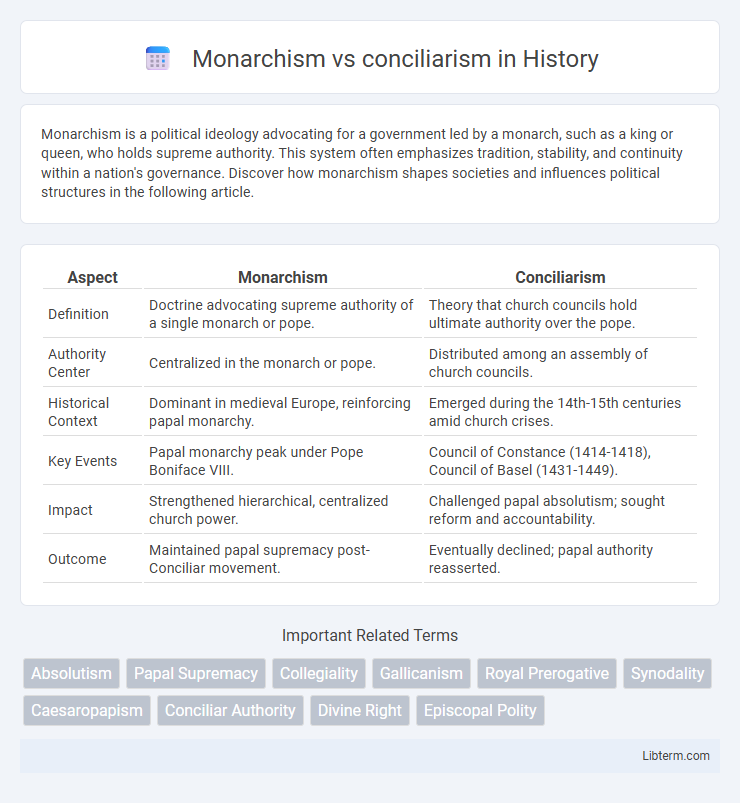Monarchism is a political ideology advocating for a government led by a monarch, such as a king or queen, who holds supreme authority. This system often emphasizes tradition, stability, and continuity within a nation's governance. Discover how monarchism shapes societies and influences political structures in the following article.
Table of Comparison
| Aspect | Monarchism | Conciliarism |
|---|---|---|
| Definition | Doctrine advocating supreme authority of a single monarch or pope. | Theory that church councils hold ultimate authority over the pope. |
| Authority Center | Centralized in the monarch or pope. | Distributed among an assembly of church councils. |
| Historical Context | Dominant in medieval Europe, reinforcing papal monarchy. | Emerged during the 14th-15th centuries amid church crises. |
| Key Events | Papal monarchy peak under Pope Boniface VIII. | Council of Constance (1414-1418), Council of Basel (1431-1449). |
| Impact | Strengthened hierarchical, centralized church power. | Challenged papal absolutism; sought reform and accountability. |
| Outcome | Maintained papal supremacy post-Conciliar movement. | Eventually declined; papal authority reasserted. |
Introduction to Monarchism and Conciliarism
Monarchism advocates for centralized authority vested in a single sovereign, emphasizing the divine right of kings and hierarchical governance within the church and state. Conciliarism challenges this by promoting the supremacy of ecumenical councils over papal authority, asserting collective decision-making in church matters. Both ideologies significantly shaped medieval and early modern political and religious structures in Europe.
Historical Origins and Evolution
Monarchism, rooted in the consolidation of royal authority during the early medieval period, emphasized the divine right of kings and centralized power within a single sovereign. Conciliarism emerged in the 14th and 15th centuries as a response to the Catholic Church's internal crises, advocating that ecumenical councils held supreme authority over the pope to reform church governance. The evolution of monarchism reinforced national sovereignty, while conciliarism's rise influenced significant ecclesiastical reforms and diminished papal absolutism during the Western Schism.
Core Principles of Monarchism
Monarchism centers on the principle of supreme authority vested in a single sovereign, often justified by divine right, ensuring unified leadership and continuity of governance. This core concept supports centralized decision-making, where the monarch embodies both political and religious legitimacy. In contrast, conciliarism emphasizes the collective authority of church councils over papal power, advocating for a more distributed and accountable governance model within the ecclesiastical hierarchy.
Key Tenets of Conciliarism
Conciliarism asserts that ultimate authority in the Church resides in an ecumenical council rather than a single monarch or pope, emphasizing collective decision-making to resolve doctrinal disputes and ecclesiastical crises. It promotes the principle that councils have the power to depose or regulate popes, ensuring accountability and preventing autocratic rule within the Church hierarchy. This doctrine contrasts sharply with monarchism, which centralizes authority in a single sovereign or pontiff, highlighting a fundamental conflict over the locus of spiritual and administrative power.
Major Figures and Proponents
Monarchism, advocated by figures like Jean Bodin and Thomas Hobbes, emphasized centralized royal authority as essential to maintaining order and sovereignty. Conciliarism was championed by thinkers such as Jean Gerson and Pierre d'Ailly, who argued for the supremacy of church councils over papal authority in resolving ecclesiastical disputes. The conflict between monarchist advocates and conciliar proponents shaped the political and religious landscape of late medieval and early modern Europe.
Case Studies in Historical Conflicts
Monarchism, advocating absolute royal authority, clashed with conciliarism, which promoted ecclesiastical councils over papal supremacy, most notably during the Western Schism (1378-1417). The Council of Constance (1414-1418) exemplifies conciliarism's peak, successfully resolving papal disputes by asserting council authority over divided monarchist claims. Conflicts in France and England reveal how monarchist rulers resisted conciliar challenges, emphasizing centralized power to control church appointments and maintain national sovereignty.
Impact on Political and Religious Institutions
Monarchism centralized authority in a single sovereign, reinforcing hierarchical structures in both political and religious institutions by aligning church leadership closely with royal power. Conciliarism challenged papal supremacy by advocating for councils as the highest ecclesiastical authority, promoting collective decision-making and reducing absolutist control within the Catholic Church. This conflict reshaped governance models, influencing the balance of power between temporal rulers and religious authorities across Europe.
Comparative Analysis of Governance Outcomes
Monarchism centralizes political authority in a single sovereign, often fostering streamlined decision-making and consistent policy enforcement, while conciliarism distributes power among councils, promoting broader participation and deliberation at the cost of slower governance processes. Historical examples reveal monarchies achieving rapid mobilization and unified state agendas, contrasting with conciliar systems that tend to balance interests but risk factionalism and indecision. Governance outcomes under monarchism typically emphasize stability and centralized control, whereas conciliarism highlights inclusivity and collective legitimacy in decision-making.
Contemporary Relevance and Resurgence
Monarchism's contemporary relevance is evident in the persistence of constitutional monarchies like the United Kingdom and Sweden, where monarchs symbolize national unity and continuity. Conciliarism, advocating for church councils' supremacy over papal authority, resurfaces amid debates on institutional reform within the Catholic Church, particularly concerning governance transparency and accountability. Both doctrines influence current discussions on authority distribution in political and religious institutions, reflecting broader societal concerns about centralized power and participatory governance.
Conclusion: Legacy and Future Debates
Monarchism emphasized centralized authority and divine right, shaping the political landscape of medieval and early modern Europe, while conciliarism advocated for the supremacy of church councils over papal authority, influencing ecclesiastical reforms. The legacy of these ideologies persists in contemporary discussions about governance, church-state relations, and authority distribution within institutions. Ongoing debates examine how lessons from Monarchism and conciliarism can inform modern political theory and institutional checks and balances.
Monarchism Infographic

 libterm.com
libterm.com